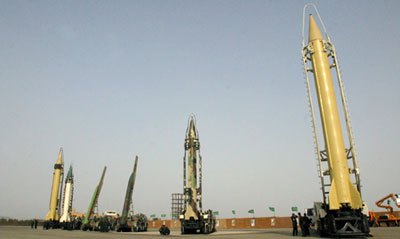A solid but flawed reportby Taylor Dinerman
|
| Recent history shows that when a nation such as North Korea, Iran, or Pakistan sets out to develop nuclear weapons, they invariably also begin work on long-range ballistic missiles designed to carry them. |
Now we have the just-published report “World at Risk, The Report of the Commission of the Prevention of Weapons of Mass Destruction Proliferation and Terrorism”, chaired by former US Senators Bob Graham and Jim Talent. Like Hart-Rudman, this study is a product of a bipartisan group of what the British call “the great and the good” members in good standing of the establishment. The report is quite good at covering the dangers of the proliferation of nuclear and biological weapons themselves, but it fails to pay attention to delivery systems, particularly long-range missiles.
Recent history shows that when a nation such as North Korea, Iran, or Pakistan sets out to develop nuclear weapons, they invariably also begin work on long-range ballistic missiles designed to carry them. While there is a fascination in the press with so-called “suitcase nukes”, the vast majority of nuclear weapons ever built were designed to fit underneath airplanes, into artillery tubes, or on top of rockets of various shapes and sizes. The current atomic arsenals of both the US and Russia are largely composed, with few exceptions, of missile warheads. There is a reason for this.
Smuggling nuclear weapons is, it would seem, a lot harder than it looks in the movies and on TV. Since the attack on 9/11 the much-derided Department of Homeland Security has in fact put a large number of detection portals and other devices at the most important US points of entry. There is always a chance that a nuclear weapon could be snuck in, but it’s a very unreliable way to get a device to its target.
A ship with a weapon could conceivably blow itself up off shore, but still close enough to contaminate a large area, but this is almost as difficult as trying to penetrate the borders. There are other ways as well; terrorists are not known for their lack of imagination.
However, when it comes to hitting a target reliably and decisively, nothing beats a long-range missile with one or more nuclear warheads. This is particularly true when it comes to attacking nations that have no missile defenses. The Graham-Talent report focuses on stopping rogue states and terrorists from getting their hands on the fissile material that goes into a weapon. This is a hard problem, made harder by the fact that the technology for making plutonium and highly-enriched uranium has been around since the 1940s. The same goes for long-range rockets.
There are several international agreements aimed at preventing the spread of nuclear weapons. These have shown their limits, particularly in North Korea and Iran. This report suggests several ways in which these agreements could be strengthened. Some of the suggestions are logical, but others such as the idea that the US should take the lead by “imposing a range of penalties for Non Proliferation Treaty (NPT) violations” have been tried by both the Clinton and Bush administrations and have not been to successful.
The report does not make mention of the Missile Technology Control Regime (MTCR) which, as of now, is the only existing international agreement aimed at preventing the proliferation of long-range missiles, which it defines as as being able to carry more than 500 kilograms over 300 kilometers. The MTCR is an exceptionally weak arms control mechanism and the dual-use nature of missiles as both weapons carriers and as space launch vehicles tends to undermine it. Crafting a new and stronger version of this regime is almost impossible. There are too many obstacles, beginning with the right of every nation under the Outer Space Treaty to have their own sovereign way of getting into orbit.
| One of the most insoluble problems of our times is the inability to agree on a workable structure to prevent dual-use technologies from getting into the hands of our enemies and at the same time allowing peaceful commerce to flow. |
The MTCR guidelines state that they are “not designed to impede national space programs or international cooperation in such programs as long as such programs could not contribute to delivery systems for weapons of mass destruction.” If this formula were to be taken literally it would be impossible to sell space launch services across national borders since all such sales do contribute, in some degree, to the development of ICBMs or IRBMs. Italy, for example, could be considered to be breaking the MTCR by launching their Cosmo-Skymed radar satellites on the US Delta 2. After all, the solid rocket boosters on the Delta 2 contribute to sharpening US technology in this area and thus to America’s ability to maintain and refurbish the Minuteman and Trident nuclear missiles.
One of the most insoluble problems of our times is the inability of the US and its allies to agree on a workable structure to prevent dual-use technologies from getting into the hands of our enemies and at the same time allowing peaceful commerce to flow. The abomination that is the ITAR regulations is one result. If things do not change we will have the worst of all worlds, more and more WMD and less and less legitimate international trade.
